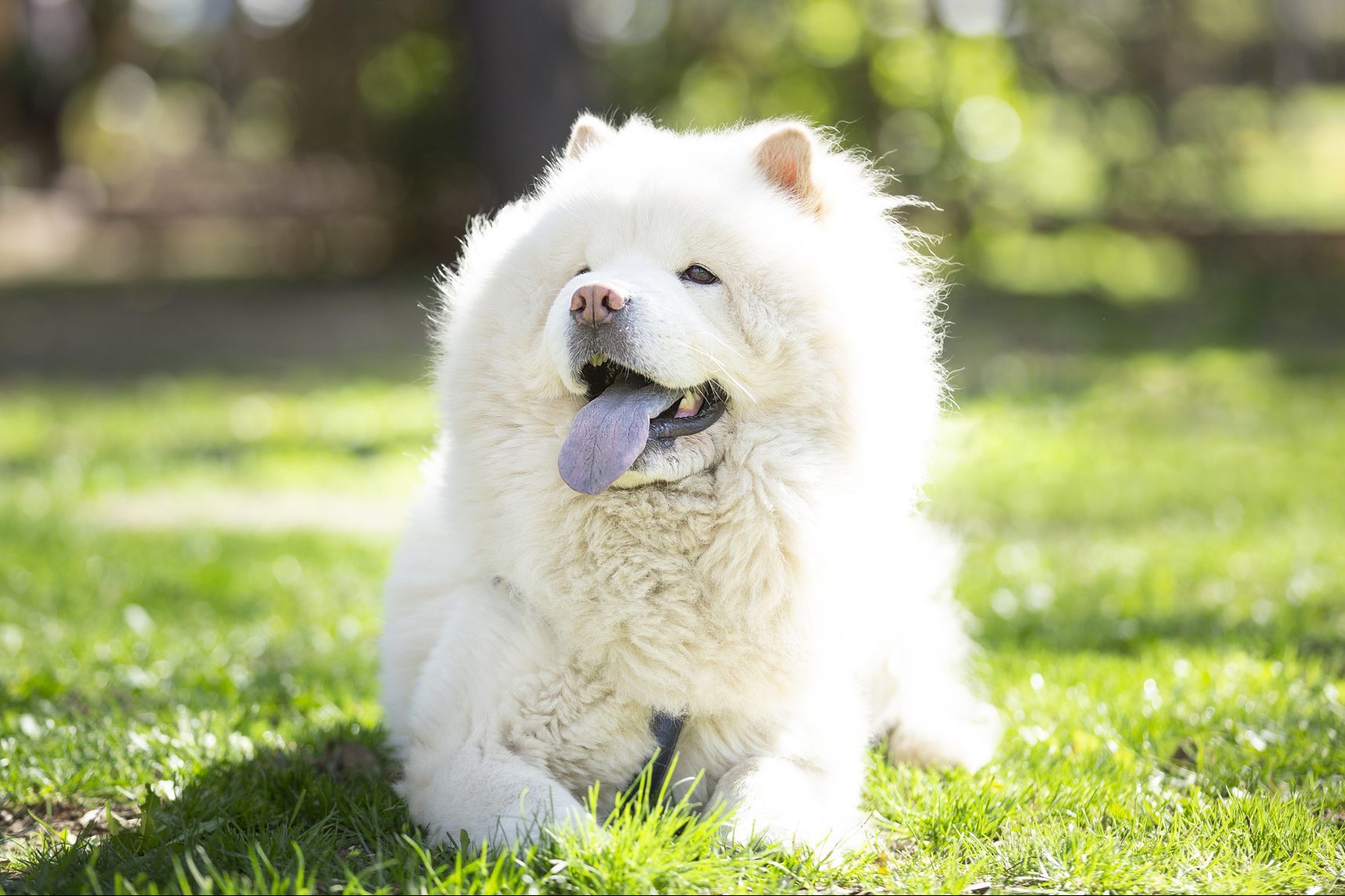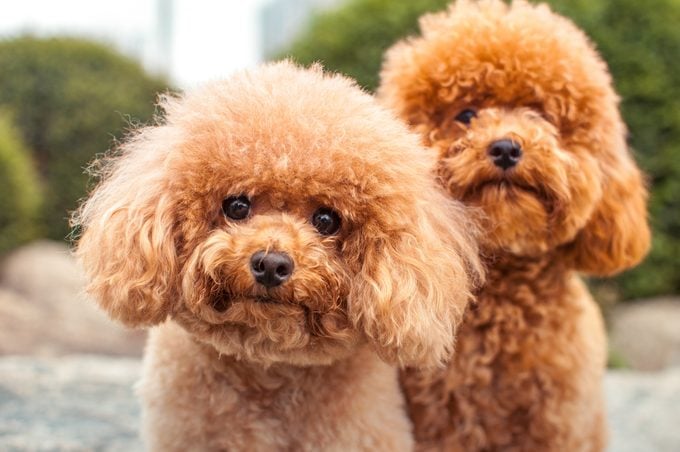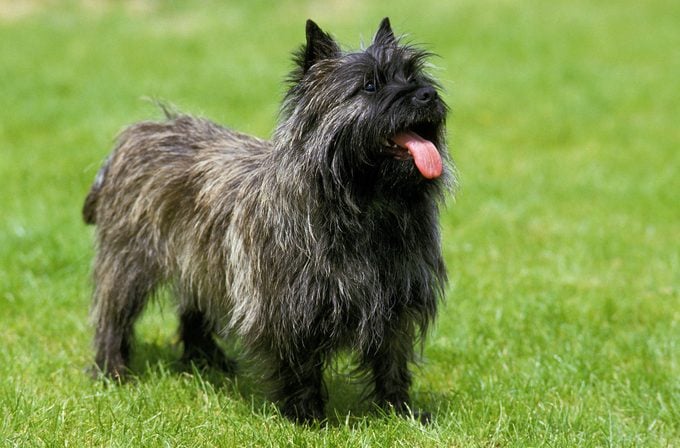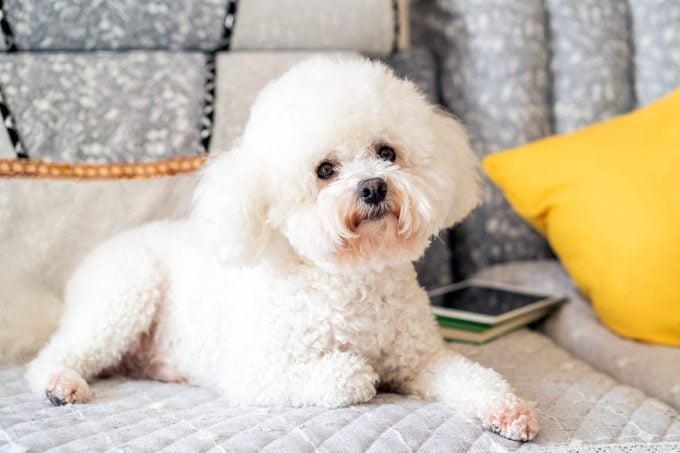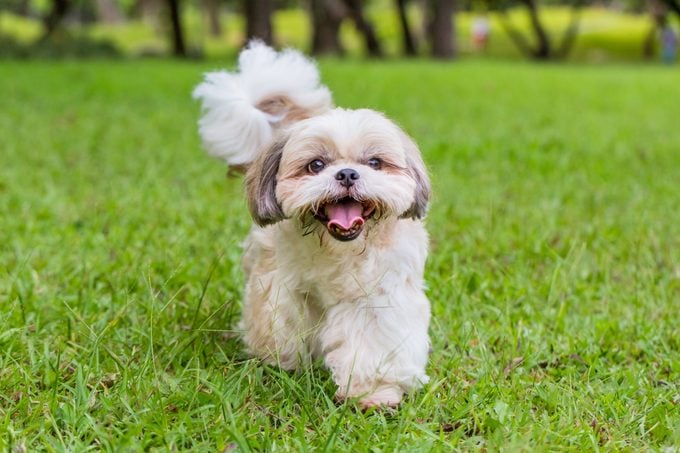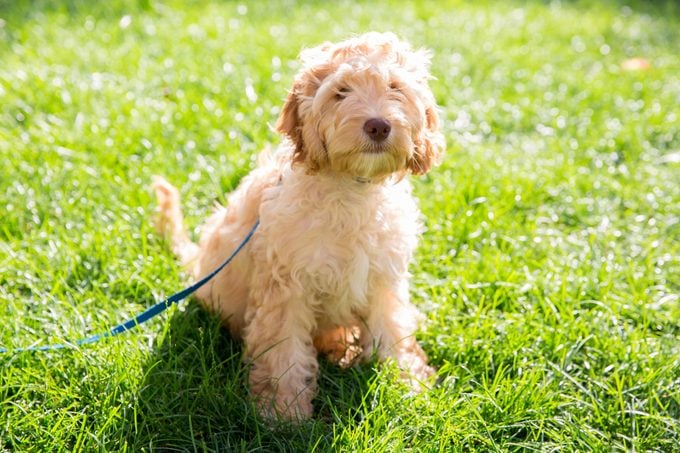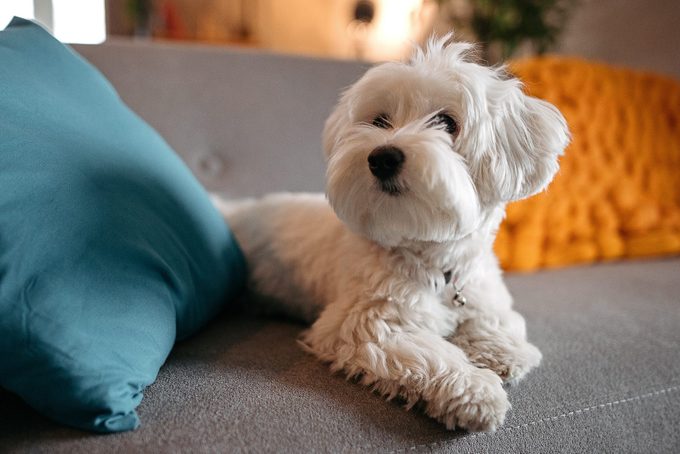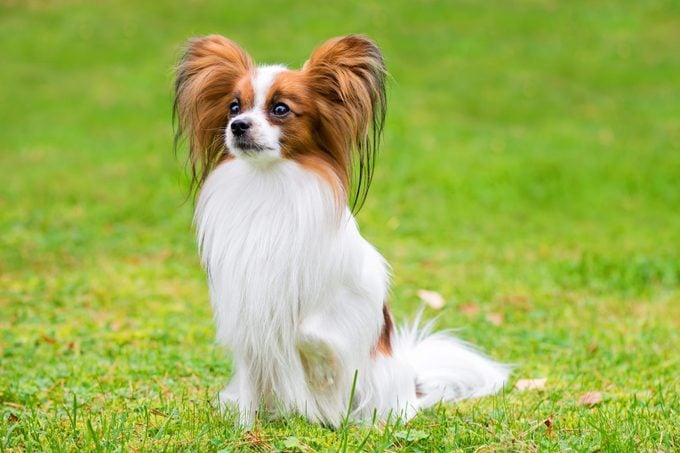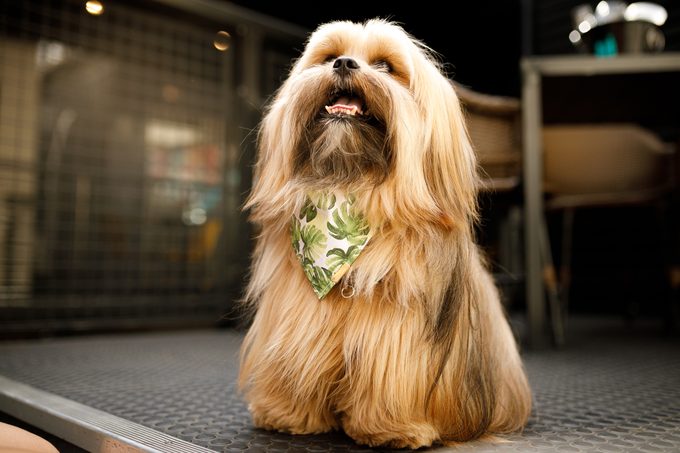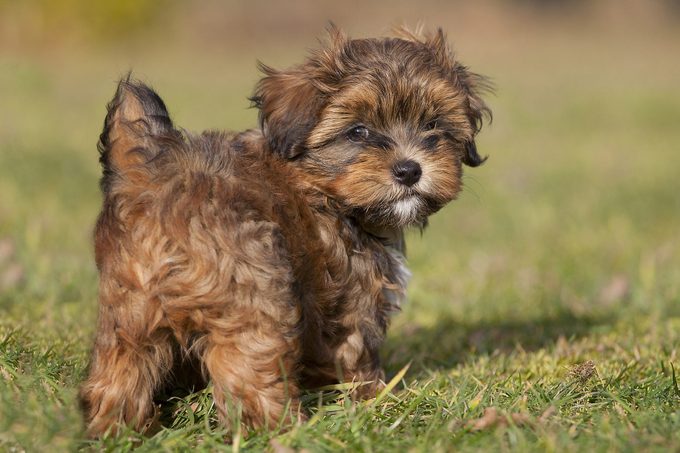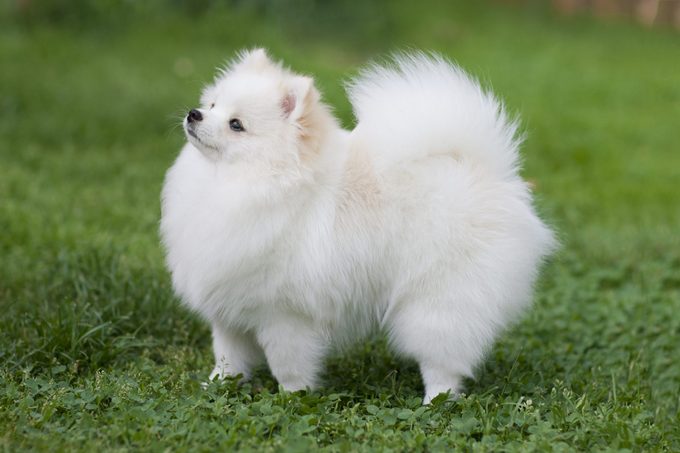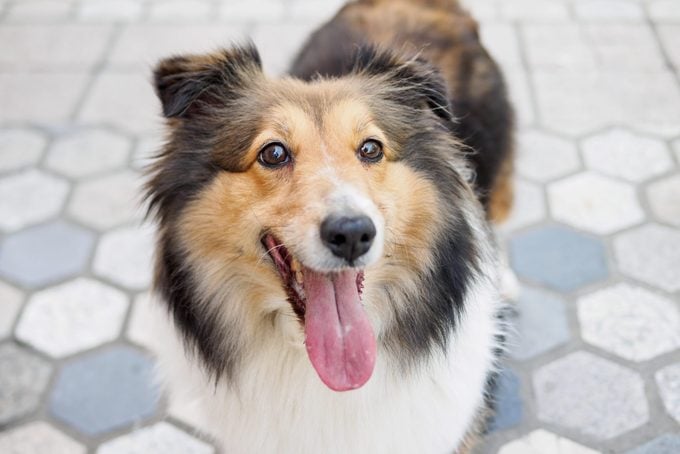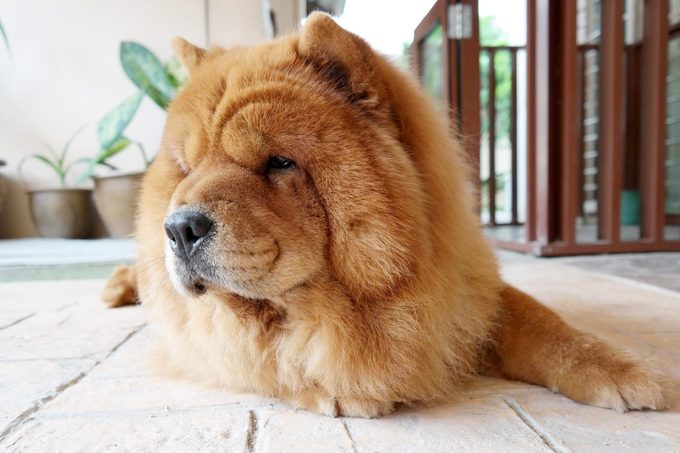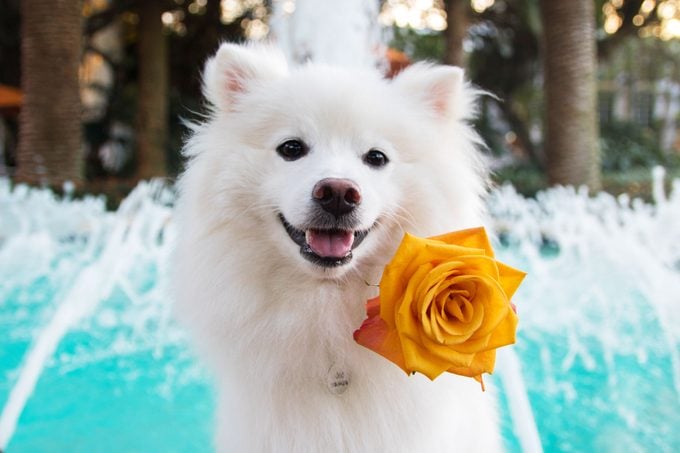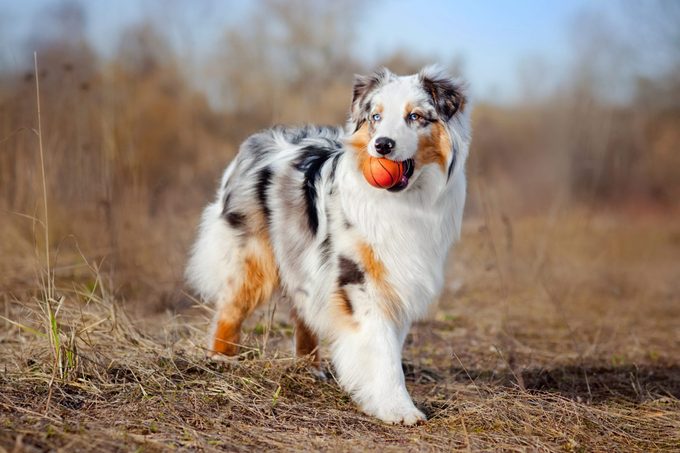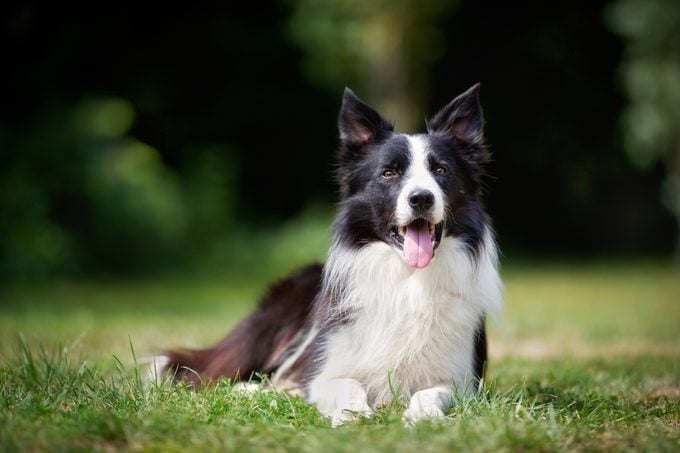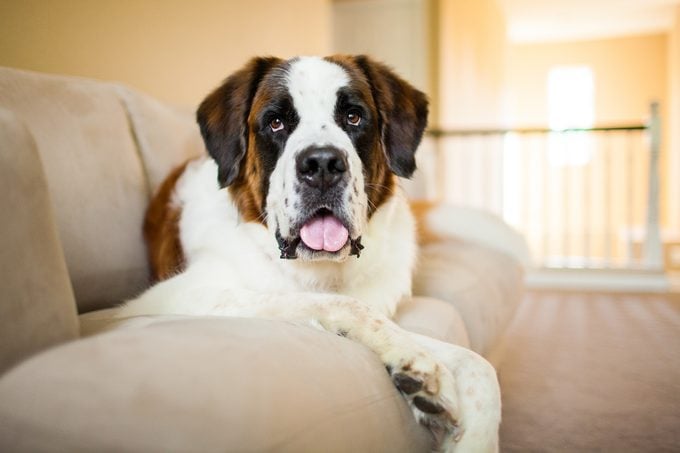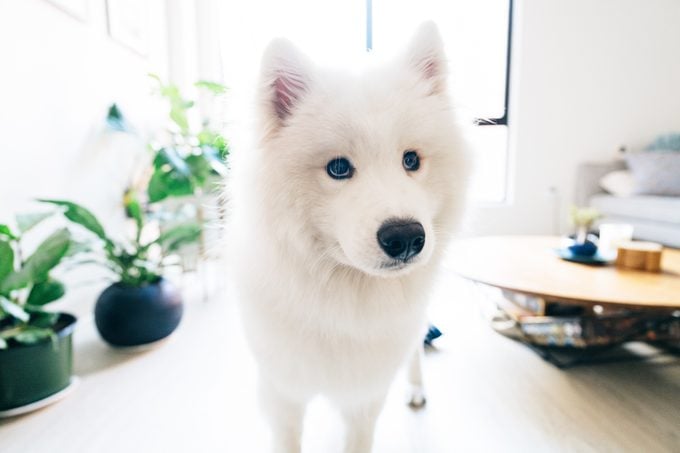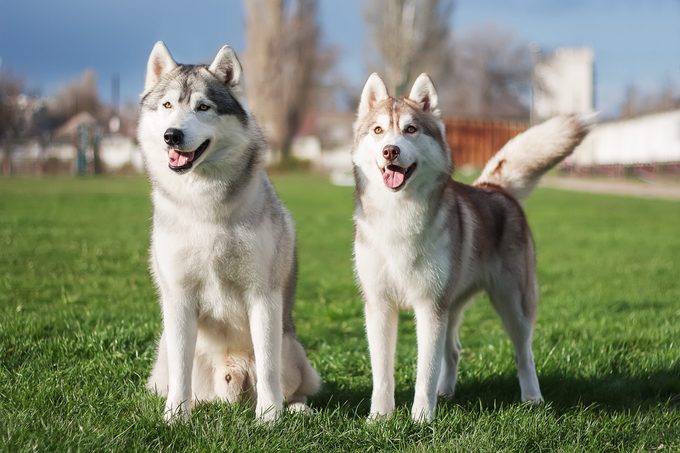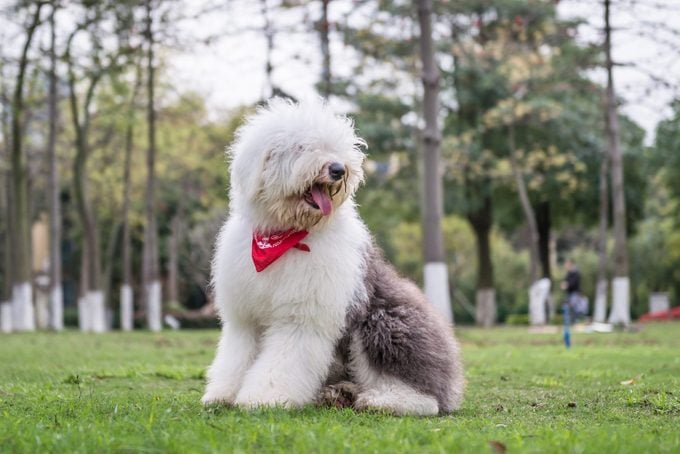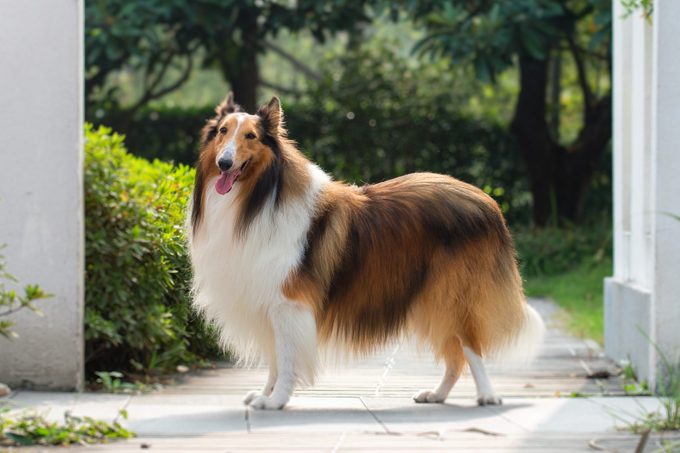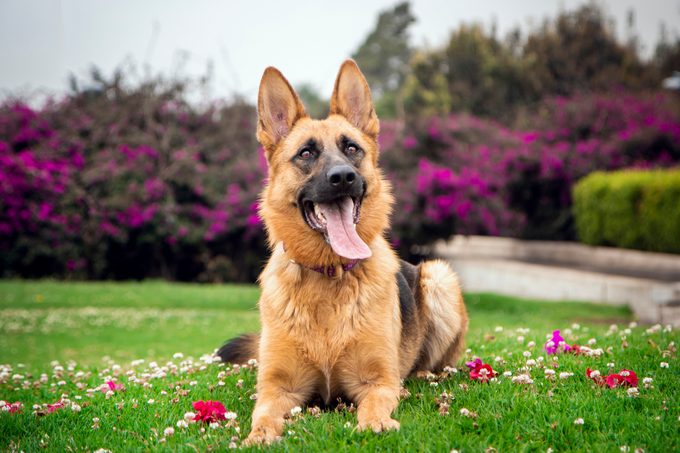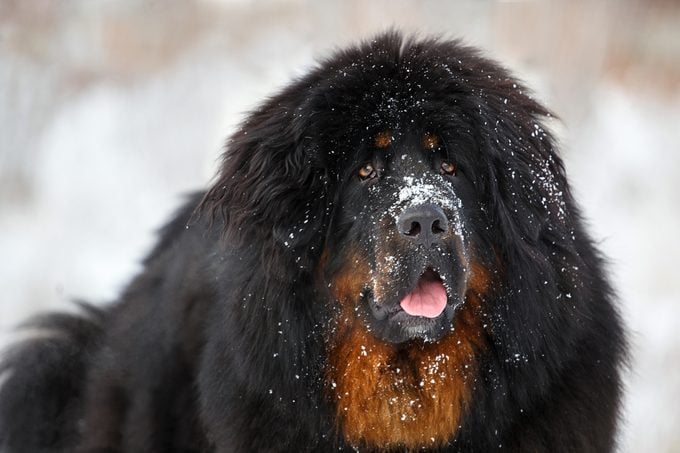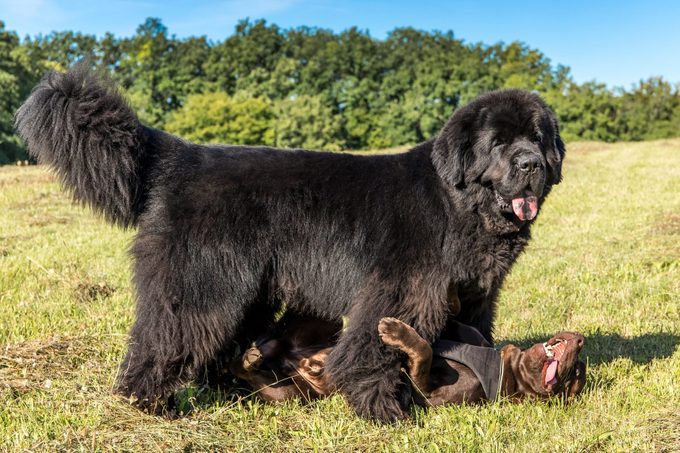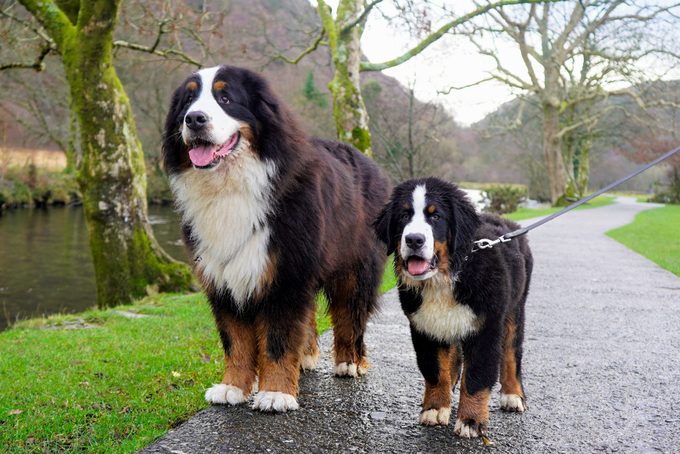If your idea of the perfect dog involves lots of fluff and puff, take a look at these adorable dog breeds with fluffy, cloud-like coats, including a few that don’t shed!
While all dogs are lovable, some people are drawn to certain “looks” in a dog. And if you’re one of those who “oohs” and “ahhs” over a fluffy, puffy dog with a billowy, cloud-like coat, you’re in luck! There are dozens of dog breeds that fit this description. Their fluffy appearances often give them the look of an adorable stuffed animal—some even look like teddy bears—and there’s nothing like running your hands through that soft, thick fur as you pet them. But if you’ve never owned a four-legged fluffball before, there are a few things you should know, according to the American Kennel Club.
- Most fluffy dogs have undercoats—a second layer of fur that insulates them in cold weather and gives them their fluffy appearance. That fine, fuzzy fur is what most often gets shed…all over your couch or favorite sweater.
- Most fluffy dogs are major shedders, especially when they “blow out” their undercoats in the spring and fall.
- Fluffy dogs are a grooming commitment, as they require frequent brushing, or else their fur can get matted and tangled. You may want to consider regular, professional grooming. You’ll also need a good vacuum cleaner!
- These fluffy pups were mostly bred for cold climates and snow, so they don’t do well in the heat. In warm weather, they shouldn’t be left outdoors for long periods of time or allowed to overheat when exercising. They need lots of water, an air-conditioned interior, and, ideally, a cool tile floor to lay on.
- A few fluffy dog breeds don’t actually shed and are considered hypoallergenic breeds, which are recommended for people with allergies.
Before you shop for a new fluffy or curly-haired dog, remember to check your local shelter, where a lovable furball may be waiting for you to take him home. Another smart option: Try reaching out to breed-specific rescue groups in your area.
Small fluffy dogs
Toy and miniature poodles
The quintessential lap—or purse!—dog, toy and miniature poodles are little bundles of hypoallergenic, non-shedding joy. All poodles are considered among some of the smartest breeds of dogs, so they’re easy to house- and leash-train, and they can even be taught to do some cute tricks, especially when there’s a dog treat involved. Non-shedding doesn’t mean non-maintenance, though. Poodles need regular brushing; otherwise, their fur will mat. Unless regularly trimmed, their fur can get quite long, tangled and matted—that’s why you see so many poodles at the dog groomers.
Cairn terrier
The Wicked Witch of the West might not have liked Toto, but she probably couldn’t blame it on his shedding. Despite their fluffy coats, Cairn terriers—of which Toto from The Wizard of Oz is still the most famous—are only moderate shedders. Still, these alert, curious little pups do well with weekly brushing. While lovable Cairns make great family and apartment dogs, they’re also highly intelligent and may try to test their boundaries.
Bichon Frise
The original puffball dog, the Bichon Frise, with its billowing white fur and black button eyes and nose, is almost comically cute. And despite all that fur blowing in the wind as they bound through the dog bark, Bichons are relatively low shedders and, while not totally hypoallergenic, still a good choice for those with mild pet allergies. They need to be brushed out a few times a week, to eliminate undercoat shed. They also need to be trimmed frequently in order to maintain their teddy bear look, so these little divas make regular trips to the groomer. But Bichons are not prima donnas—these happy, friendly dogs fall in love with everyone they meet!
Shih Tzu
Once the lapdogs of Chinese royalty, Shih Tzus have long been a favorite toy breed in the United States. Their long, silky, fluffy coats will dust the floor if they’re not trimmed—if you’ve ever seen a Shih Tzu before and after it’s been to the groomer, it’s like seeing two different dogs! Playful, loving Shih Tzus adore spending time with their human companions, and are more content with a short walk to the coffee shop than they are with a run in the dog park. Plus Shihs are one of the few breeds that need their own hair accessories—barrettes, bows, and hair ties to keep their long hair out of their eyes.
Cockapoo
A cross between a cocker spaniel and a miniature poodle, cockapoos were introduced in the 1960s and soon became a popular companion pet, especially for apartment dwellers. Their coat is soft and silky, and their fur may be wavy, curly, or straight. But because they’re half poodle, they only shed a moderate amount of fur. That said, adult cockapoos’ fur can grow up to six inches long, so you may want to get them trimmed regularly. Here’s a sweet cockapoo fact: Because this breed is so sensitive to those in need, it makes an ideal companion dog for children and adults with disabilities and special needs.
Maltese
Another dog with its own box of hair ties and bows, Maltese are a toy breed famous for their long, resplendent white fur that grazes the ground as they walk. And like Bichons, their button eyes and nose make them irresistible. But despite this regal appearance, these little guys are low shedders, and they’re also sweet, friendly family dogs. But keep the dog brush handy, as they need daily brushing to keep their coats from matting and tangling.
Papillon
Take one look at a papillon’s tall, pointy, fan-like ears and you’ll know how this dog got its name—papillon is French for “butterfly.” These winged wonders are toy-sized, but they’re tremendous athletes and excel at agility training. Their long, silky fur needs regular brushing to keep knots and mats out but otherwise is low maintenance. They don’t have an undercoat, but papillons shed, especially in summer and fall.
Lhasa Apso
Called “bearded lion dogs” in their native Tibet, Lhasa Apsos once guarded high-altitude Buddhist monasteries. In a household, they’re always ready to alert their family members and protect them from danger. Their long, fluffy, silky coats are surprisingly shed-free, though they do need regular brushing, as well as bathing about every two weeks. You can keep their fur flowing long and free, or give them a short “puppy cut” that shows off their sweet eyes.
Havanese
Looks can be deceiving. The Havanese has a long, soft coat, which might make him seem like a cold-weather dog. But this popular, affectionate breed developed in Cuba, and its coat actually protects it from heat and sun. Havanese are low shedders, making them a good choice for allergy sufferers. But that long fur does need frequent brushing. Fortunately, if you decide to trim a Havanese’s fur, they look just as cute with a short cut as they do with a long one!
Pomeranian
High-energy puffs of fluff, Pomeranians, one of the most popular dog breeds, appear to be all fur—and that’s sort of correct. They max out at seven pounds, though their copious double-coat fur makes them look a lot stockier. They need frequent brushing to tease out that undercoat; otherwise, you’ll find fluffy furballs wafting all over your house. This is one fluffy dog whose fur shouldn’t be cut short—he needs that dense coat to keep him warm in the winter and cool in the summer.
Medium-sized fluffy dogs
Shetland sheepdogs
Shetland sheepdogs, or Shelties, look like miniature collies and share many of the same qualities with their larger cousins: They’re highly intelligent and trainable, great family dogs, and natural herders. They also have long, fluffy hair and a thick undercoat—perfect for Scottish winters but not so great for your couch. These agreeable pups need at least weekly brushing and frequent de-matting.
Chow Chow
Two major traits distinguish a Chow Chow, sometimes just called a Chow—its black tongue and its thick, fluffy coat and lion-like mane. One of the world’s oldest breeds of dogs, Chow Chows have been used as companion dogs, guard dogs, and hunting dogs. They have a strong protective streak and do best in homes with no other dogs. To control their dense undercoat, brush two to three times a week, more often in shedding season.
American Eskimo
Despite their all-American name, these medium-sized white puffballs originated in Germany; they were given a more patriotic name during World War I. Their short, thick undercoat helps give a fluffy look to their longer outer coat. These kid-friendly, affectionate dogs are shedders and need to be brushed at least once a week, more during shedding season.
Australian sheepdog
While not all Australian sheepdogs have blue eyes, the affable breed is famous for its icy-blue eyes—many also have two different-colored eyes. Super smart and in need of regular exercise and stimulation, these friendly dogs make great additions to active families. Their fluffy undercoats require frequent brushing or raking, particularly in shedding season and after they’ve had a romp out in the yard.
Border collie
Like their Australian kin, Border collies are incredibly intelligent, active dogs that need to be challenged with regular activities, like agility courses or even herding. They will chase and retrieve a ball until their owner falls down from exhaustion. Their double coats need to be brushed a few times a week, and be forewarned—Border collies like to play in the mud! These loyal, nimble pups are best for owners with a lot of time to devote to them.
Big fluffy dogs
Saint Bernard
Immortalized in history for rescuing stranded travelers in the Swiss and Italian Alps, giant Saint Bernards are loyal, playful dogs and can be big goofballs. Both long- and short-hair varieties do some major shedding, so you’ll need to brush them frequently. Saints can’t handle hot weather or sustained bouts of exercise. Rambunctious as puppies, they’ll happy mellow out as they mature.
Samoyed
There are a lot of cute, white fluffball dogs out there, and Samoyeds are among the biggest of the bunch. This working dog got its start in Siberia, where it herded and protected reindeer in temperatures that could reach -60 degrees Fahrenheit. Most Samoyeds now have an easier lifestyle, but they still like to be engaged in play or exercise. Their ultra-thick double coat sheds year-round, so have that dog brush at the ready!
Siberian husky
Often with one blue eye and one brown one, elegant Siberian huskies are friendly with kids and other animals, though they do have a strong chase instinct and need room to run…though not necessarily pulling a sled across Arctic tundra. Insulated against the cold climate from which they originated, these beauties need frequent brushing and de-matting, yet infrequent baths—they’re one of the cleanest breeds out there.
Old English sheepdog
Peekaboo! Old English sheepdogs are known for their fabulous fluffy coats, including fur that frequently covers their eyes and gives them a comic look. While an OES may very well be the clown of the family, caring for his coat is no joke—he needs brushed several times a week, and his paw fur needs to be trimmed to keep it from matting and accumulating assorted dirt and crud. And OES owners, be advised: Shedding happens.
Rough collie
Distinct for their long nose and narrow face, rough collies also have luxurious, billowy fur that needs regular brushing, with special attention around the ears and haunches, where matting can occur. Collies were known for their loyalty and friendliness long before Lassie came along, and they remain a steadfastly loving family dog, especially with young children.
German shepherd
A hero breed if there ever was one, German shepherds are known for running into danger, especially to protect a loved one or, for K9 or military workers, in the line of duty. Their loyalty, intelligence, and protectiveness make them great family dogs. Their fluffy double coats can lead to tumbleweeds of dog hair drifting around your house if you don’t brush them regularly, especially in shedding season.
Tibetan mastiff
A giant among dog breeds, Tibetan mastiffs can tip the scales at 150 pounds—only some of which is made up of copious amounts of fur! It gets pretty cold in mountainous Tibet, and this ancient breed still has the dense coat to show for it. Expect a huge shedding event twice a year and to do at least weekly brushing the rest of the time.
Newfoundland
Expect the fur—and the drool—to fly when you welcome a sweet, fun-loving Newfoundland into your home. These gentle giants are water dogs and were used as rescue dogs and as fishermens’ helpers in their native Canada. Newfs still love to swim, so treating yours to an outing at a lake or beach will send him over the moon. These big beauties need to be brushed out at least once a week, and when it’s shedding season, well…get ready to vacuum.
Bernese mountain dog
With an expression and demeanor similar to its fellow Swiss breed the Saint Bernard, Bernese mountain dogs were bred for herding, not for rescuing snowbound travelers. Today, they make great family pets and do especially well with children. Their double fur coat will blow out twice a year, so expect some major shedding. Regular brushing and detangling is a must.
Great Pyrenees
Tall, furry, and acutely aware of their surroundings, Great Pyrenees—named for the western European mountain range—were first used as sheepdogs, always ready to tangle with a menacing bear, wolf, or sheep rustler. Today, these strong-willed dogs can make great family companions, but they do need a steady, consistent hand. And that white, fluffy fur? Expect a spectacular spring “blow out” that can be (somewhat) alleviated by frequent brushing.
wp-user-id=7433

